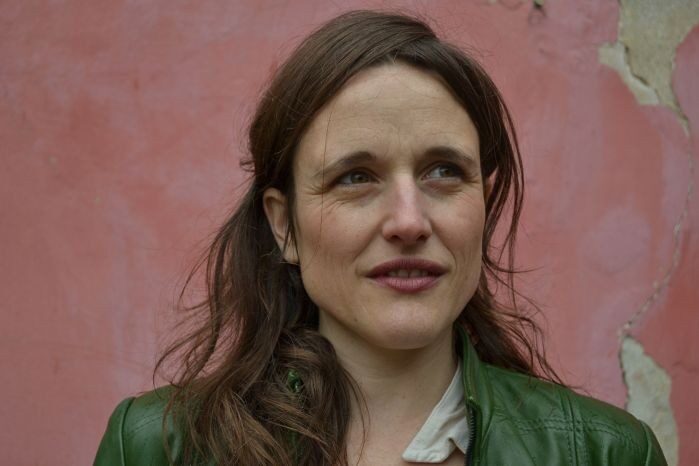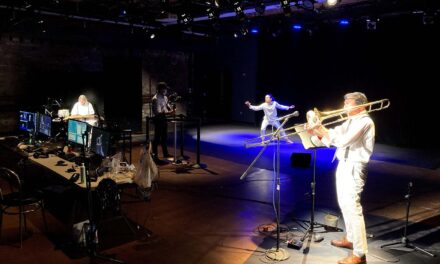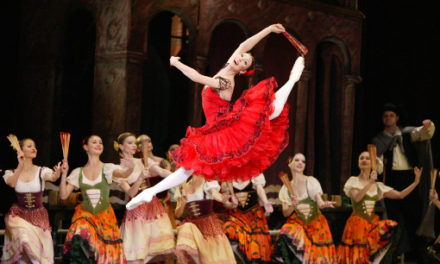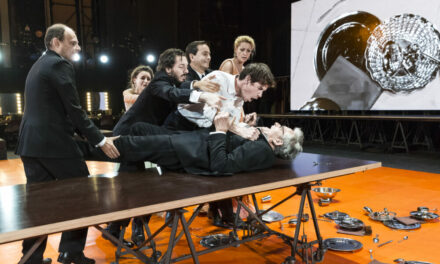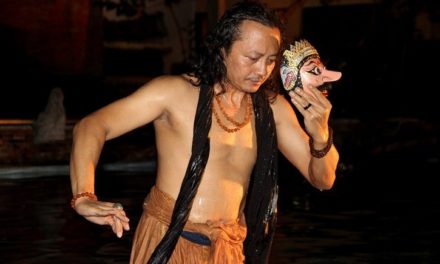New York City’s HERE Arts Center will present the U.S. premiere of Anywhere by Théâtre de L’entrouvert – Elise Vigneron from March 11 to March 15.
Before leaving France, Elise Vigneron spoke with us about her creations.
Nicole Birmann Bloom: In your biography, we read that you had a multidisciplinary start: visual arts, drama, circus, puppetry, with the latter prominent in Anywhere, which will be presented soon at HERE Arts Center.
Elise Vigneron: Anywhere is a visual show freely inspired by a text: Oedipus on the road, by Henry Bauchau. The dramaturgy is constructed around materials in transformation and bodies in movement, the puppet’s body made of glass — the character of Oedipus — and the actor’s body in the flesh — the character of Antigone. The meeting of ice and fire, of hot and cold, of living and inanimate, as well as mirror tricks between two bodies, create strong images, symbols that speak to the feelings of the audience.
Nicole: How did you encounter the art of puppetry and how was it different for you from your other artistic experiences?
Elise: First, I studied fine arts, developing sculptures and bringing organic materials into play. During my childhood, I practiced trapeze and dreamed of joining the circus. When I was 19 years old, I entered a professional school of circus arts. But I got hurt, and, for a year, I could no longer do sports. It is thus that I got to know the art of puppetry, this art at the intersection of fine arts and movement that provided me with great liberty of expression right away. More than a technique, puppetry arts allow me to create a silent language that expresses states and recounts ideas that we cannot form with words. By animating a marionette or a material, there is something magical and archaic that speaks profoundly to our unconscious and our inner selves, awakening buried memories.
Nicole: Anywhere is freely inspired by Henry Bachau’s book’s novel Oedipus on the Road, and your recent creation, L’enfant on Maurice Maeterlinck’s play The Death of Tintagiles for string puppetry. From the written language to a visual and sensory experience, could you tell us more about your process with your team, among them Hélène Barreau, another puppeteer?
Elise: Each project is a new exploration of unknown territories. Anywhere, with Hélène constructing a marionette from ice and manipulating it, encountered numerous difficulties and moments of great incertitude. Ice is a very fragile material and water is difficult to master, but we found solutions for each challenge. For example, once we discovered how to construct a marionette from ice, without issues of leakage, deformations of the mold, and shrinkages of the structure, I started to want to manipulate the marionette as if it were a traditional, fabric marionette. Thus, we hit new difficulties – it was too heavy and completely unmanageable because it was slippery. Faced with these obstacles, we developed a technique of manipulation from a distance, with very long strings. I wanted to develop this same technique in the show L’Enfant because it truly allows the marionette to come alive without the presence of the manipulator. To work with the material, you must remain open and attentive because you cannot merely execute a predetermined plan when the material is bringing you to explore new domains. It is an initiatory process. At each show, the entire team of Anywhere is on alert, like a lion tamer during his number, because the material always brings surprises and we need to know how to respond.
Nicole: All of your productions have a pedagogical component and you are careful to share a specific moment with the audience. Could you share with us one of your most striking moments with the audience, whether during a performance or discussion or workshop?
Elise: Indeed, I find that it is important to have moments of interaction with the audience to discuss how they perceived the show — It is a collective experience that we live altogether. I need this time of sharing because it is a show that is open to the interpretation of each viewer. Because it is not narrative, certain viewers can be a little lost, but it is by distancing them from their habits that they can discover another way to understand the show. This asks people to let go and to trust their feelings. Like Bauchau says, “Each person is soon going to have to rediscover the path of their thoughts and trace the unknown path that corresponds to their internal image on the ground and in the sky.”
I like to perform this show abroad or with an audience that is not used to this type of form, like young audiences because the feedback is always very direct and spontaneous. And, very often, I receive feedback that goes much further than what I could have imagined myself. We have had the opportunity to perform in Korea and China, and I have been very touched by the feedback of the audience because they gave words to the images that I had imagined in a very intuitive way. There, it is not the narration that counts, but the symbols. After each show, we had large, collective exchanges that were metaphysical and rich, which continued to nourish my work.
Nicole: What is your next project?
Elise: I am just at the beginning of reflecting on a new project. I hope to push my research on ice further and to work with a dancer and multiple bodies of ice of human size. I am going to collaborate with scientists to test the acceleration of different solid states into liquid. I always have a text from which to draw inspiration, for this show, it will be The Waves, by Virginia Woolf.
Thank you, Elise. We are looking forward to seeing Anywhere
The interview was conducted by Nicole Birmann Bloom, Program Officer, Performing arts. Translation into English was done by Jessica Cohen
This article was first posted at FrenchCulture.Org in March 2020 and has been reposted with permission. To read the original article, click here
This post was written by the author in their personal capacity.The opinions expressed in this article are the author’s own and do not reflect the view of The Theatre Times, their staff or collaborators.
This post was written by Nicole Birmann Bloom.
The views expressed here belong to the author and do not necessarily reflect our views and opinions.

